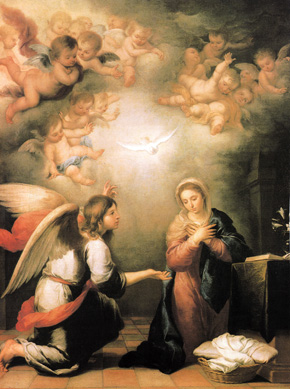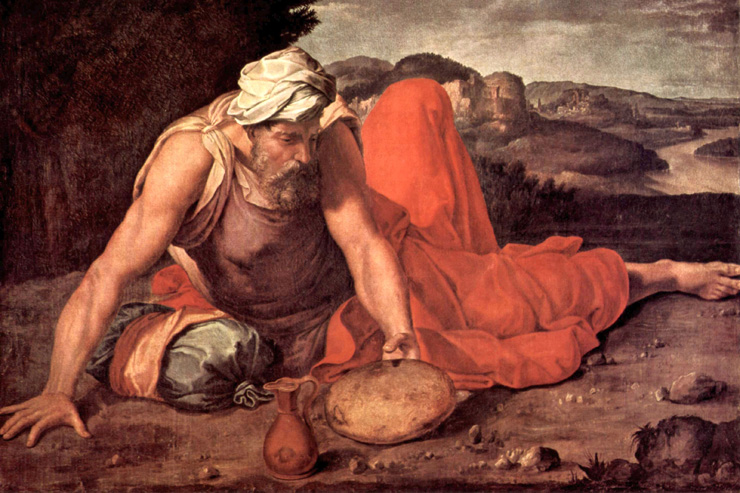Knowing Mary Through the Bible: The Original Mary
Our Lady’s Life Before the Annunciation
by Edward P. Sri

Annunciation - by Murillo
What was Mary’s life like before the angel Gabriel appeared to her?
Mary’s early years are shrouded in mystery. The Bible doesn’t tell us much about her existence before the Annunciation. However, the few details that the Gospel of Luke provides allow us at least to catch a glimpse of Mary’s life before the fateful day when she would become the mother of the Messiah.
In this [Knowing Mary Through the Bible] series, we … explore what Scripture tells us about the Blessed Virgin Mary. Who was Mary? What was her life like? What was her role in her Son’s mission? And how does she continue to play a part in our lives today? While we may touch upon some apologetics questions and doctrinal issues along the way, my goal is simply to unearth the Scriptural data about Mary so that we can come to know and love her better through the Bible.
Nowhere Nazareth: A Surprising Choice
Consider what we can learn about Mary’s pre-Annunciation life in the following verses:
In the sixth month the angel Gabriel was sent from God to a city of Galilee named Nazareth, to a virgin betrothed to a man whose name was Joseph, of the house of David; and the virgin’s name was Mary. (Lk. 1:26–27)
Admittedly, there is not a lot here to give us a portrait of Our Lady’s early years, but there are at least three important facts we can unpack for all they’re worth.
The first fact we discover about Mary is that she dwelt in “a city of Galilee named Nazareth.” This small geographical detail is important because Nazareth would have been a very unlikely place for the messianic era to begin. Nazareth was a small, secluded agricultural village in Galilee. Far from the social-religious center of the Jerusalem Temple, Nazareth had only a few hundred inhabitants and was not directly on any major trade route. Moreover, there are no prophecies explicitly about Nazareth in the Jewish tradition, and the Old Testament never even mentions the town.
The fact that Jesus comes from Nazareth will cause him trouble later in his public ministry. Nathaniel’s famous line, “Can anything good come out of Nazareth?” (Jn. 1:46), illustrates how at least some Jews held Nazareth in rather low esteem. In the first-century Jewish world, Nazareth probably would not have made it into the “Top 10” of likely candidates for the Messiah’s hometown. That God chose a woman from this lowly city to become the mother of the Messiah would have been quite surprising.
From Zechariah to Mary
The surprising nature of God’s choice becomes even clearer when we consider how Luke’s Gospel juxtaposes Gabriel’s announcement to Mary with the same angel’s announcement to Zechariah, the father of John the Baptist, in the previous scene. First, Luke tells us that Gabriel’s announcement to Zechariah took place in the large city of Jerusalem and right in the heart of Israel’s religious center, the Temple. In contrast, Gabriel’s announcement to Mary occurs in the small, obscure village of Nazareth, and Luke doesn’t even mention the setting in which this annunciation takes place. Next, Gabriel’s first announcement is given to an honorable priest, representing a whole multitude of Jewish people in the midst of the Temple liturgy, while the second announcement was given to an unknown woman, apparently in the midst of her ordinary daily life. Finally, the annunciation to Zechariah had immediate public impact, as the multitude of people perceived that their priest had had a vision (1:10, 21–22), while the announcement to Mary seems to escape the notice of everyone around her—even though she had just received the most important angelic announcement in salvation history!
In his book Theotokos, John Paul II pointed out how the contrast between these two announcements underscores the extraordinary nature of God’s intervention in Mary’s life. “In the Virgin’s case, God’s action certainly seems surprising. Mary has no human claim to receiving the announcement of the Messiah’s coming. She is not the high priest, an official representative of the Hebrew religion, nor even a man, but a young woman without any influence in the society of her time. In addition, she is a native of Nazareth, a village which is never mentioned in the Old Testament.” By highlighting Mary’s lowliness in contrast to Zechariah’s high social status as a priest, “Luke stresses that everything in Mary derives from a sovereign grace. All that is granted to her is not due to any claim of merit, but only to God’s free and gratuitous choice” (pp. 88–89).
Mary thus stands in the biblical tradition of God choosing the people we’d least expect to play a crucial role in His plan of salvation. God surprisingly chose a man named Moses who was slow of speech and unsure of his leadership abilities to lead the people out of slavery in Egypt, and unexpectedly chose from all of Jesse’s children the youngest boy, David, to become Israel’s next king. Likewise, God chose from among all the people in first-century society not a woman from the Jewish aristocracy, nor the daughter of a chief priest in Jerusalem, nor the wife of a famous lawyer, scribe, or Pharisee, but an unknown virgin named Mary from the little village of Nazareth to become the mother of Israel’s long-awaited Messiah-King.
Betrothed, Not Engaged
The second fact we learn about Mary is that she was “a virgin” who was “betrothed.” This tells us three important things about Mary.
First, since Jewish women were typically betrothed around the age of 13, Mary probably was very young when she received this most weighty message from the angel Gabriel about her call to serve as the mother of the Messiah.
Second, as a betrothed woman, Mary would have been legally married to Joseph, but still living with her own family. Here we see how Jewish betrothal was not the same as our modern notion of engagement. Betrothal was the first step in a two-stage marriage process. At their betrothal, Mary and Joseph would have exchanged their consent to marry each other before witnesses, and this would have made them legally married. However, as a betrothed wife, Mary would have remained living with her own family apart from her husband for up to one year until the second step of marriage took place. In this second step, the husband would take his wife to his own home for normal married life to begin. Therefore, when the angel Gabriel appeared to her, Mary would have been living between these two stages of marriage: She would have been Joseph’s wife, but not yet dwelling with him.
Third, according to Jewish marriage customs, sexual relations would not take place until the second stage of marriage. Thus, since Mary is a betrothed woman and not yet living with her husband, it would come as no surprise that she was a “virgin” (1:27).
The House of David
The third and perhaps most striking fact about Mary from this opening chapter of Luke’s Gospel is that she is betrothed “to a man named Joseph, of the house of David” (1:27). Although the Scriptures are not clear as to Mary’s own ancestry (theologians debate whether she, too, was of the house of David), her betrothal to Joseph connects her to the Davidic family. This has important implications for Mary. It tells us that Mary is not part of any ordinary family, but a royal family. Indeed, “the house of David” was the most famous family in Israel’s history. David’s descendants ruled over the Jews for several centuries in the glory days of the Kingdom of Judah. And God promised David that his family would have an everlasting dynasty and that his kingdom would never end (2 Sam. 7:13, 16).
However, in the first-century world of Mary and Joseph, the Davidic dynasty seemed to have been lying dormant for centuries as one foreign nation after another ruled over the Jews. In fact, no Davidic king had sat on the throne since 586 BC, and the Romans were the latest foreign powers to control the land. Thus, for Mary, being a part of “the house of David” did not bring the privilege, honor, and authority it did in the days of the great kings of old. Mary may be married to a man who possesses the royal bloodline of the Davidic kings, but her husband is not reigning as a prince in a Jerusalem palace. Instead, he works as a humble carpenter, appearing to live a quiet, run-of-the-mill life in the secluded village of Nazareth.
On the surface, there does not appear to be anything extraordinary about Mary. She is a young woman betrothed to a man from the house of David, but she lives a seemingly ordinary life in the small, insignificant town of Nazareth.
“Full of Grace”
However, there is a lot more going on in Mary than meets the eye. Luke’s Gospel provides one more detail that shows how underneath what appears to be a normal life, God has been doing something absolutely amazing in Mary’s soul—something that has never been done before in the history of the human family. Consider the first words Gabriel says to Mary: “Hail, full of grace, the Lord is with you!” (Lk. 1:28).
“Full of Grace.” For many of us Catholics who routinely recite these words of Gabriel in the Hail Mary, the expression “full of grace” may be so familiar that we might fail to catch its profound significance. This is no ordinary greeting. In fact, no one in salvation history had ever been addressed like this before. And note that the angel does not say “Hail, Mary, full of grace.” Gabriel says, “Hail, full of grace.” The angel addresses Mary not by her personal name, but with the title “full of grace.” As some Scripture scholars, such as Joel Green in his commentary on The Gospel of Luke, have pointed out, it is as if Mary is being given a new name. John Paul II, in reflecting on this passage in his book Theotokos, said “full of grace” is “the name Mary possesses in the eyes of God” (p. 88):
In Semitic usage, a name expresses the reality of the persons and things to which it refers. As a result, the title ‘full of grace’ shows the deepest dimension of the young woman of Nazareth’s personality: fashioned by grace and the object of divine favor to the point that she can be defined by this special predilection. (p. 90)
But what does this unusual title mean? The Greek word in this passage commonly translated “full of grace” is kecharitomene. This word is in a past perfect participle form, indicating an action that began in the past and continues in the present. It literally can be translated “you who have been and continue to be graced.” In fact, the same verb is used in Ephesians 1:6–7 to describe not simply grace in the general sense of God’s showing his favor on someone, but the particular kind of divine favor that is associated with forgiveness of sins and redemption. Therefore, it is as if the angel is saying to Mary, “Hail, you who have been and continue to be graced . . . Hail, you who already have received the forgiveness of sins and the gift of redemption.”
One can appreciate why many have turned to this verse for biblical support for the Catholic doctrine of the Immaculate Conception—the belief that Mary was conceived full of grace and without the stain of original sin. Indeed, this verse indicates that Mary already had the working of grace in her life before the Annunciation scene. In other words, while certainly not serving as a definitive “proof-text” for the Immaculate Conception, Luke’s Gospel clearly reveals that Mary already had forgiveness of sins and redemption before the angel Gabriel ever appeared to her.
Gabriel’s words, therefore, reveal the most significant aspect of Mary’s early life. On the surface, she may appear to be simply a young, betrothed woman dwelling in nowhere Nazareth. But in the midst of this seemingly uneventful life, God has made her “full of grace” as He quietly prepares her for the most important mission any woman ever embraced in the history of the world: to become the Mother of God.
Acknowledgement:
Reprinted with permission from the January/February 2007 issue of Lay Witness magazine. © 2007 Catholics United for the Faith / www.cuf.org/Laywitness/index.asp
Please help us in our mission to assist readers to integrate their Catholic faith, family and work. Share this article with your family and friends via email and social media. We value your comments and encourage you to leave your thoughts below. Thank you! – The Editors












